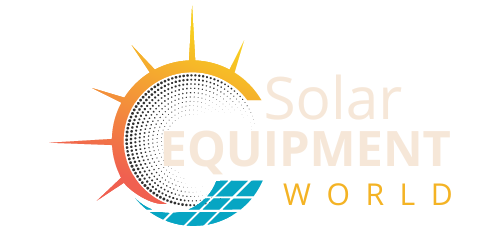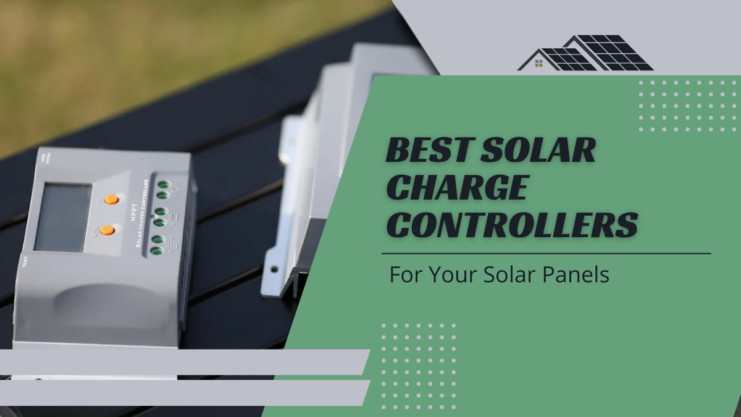Have you spent a lot setting up your Solar system or are you just about setting up your solar panel, and you are worried that the batteries might not last as much as described by the engineer due to poor usage? The solution is here, to protect your batteries, you need the best solar charge controller for your solar system, to avoid the batteries getting damaged due to overcharging.
The solar charge controller will help to optimize your batteries, thus bringing to the barest minimum, the tendency of your batteries to get overcharged and also preventing them from discharging unnecessarily.
There are presently so many variants of solar charge controllers in the open market as of today and we know you might be confused as to identifying the best solar charge controller. The aim of this article is to, first of all, help you make the right decisions on the appropriate solar charge controller to buy.
We would be showing you things/pointers to look out for in a solar charge controller before buying it. Also, we would review the best solar charge controllers in the market.
Reviews and Top Pick of the Best Solar Charge Controller
| Rank | Name Product | Image | | |
|---|---|---|---|---|
| 1
|
Morning Star Pro-Star PS-30 PWM Solar Charge Controller | 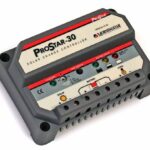 |
||
| 2 | Renology Wanderer – 30A Advanced PWM Negative-Ground Solar Charge Controller | 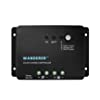 |
||
| 3 | Victron Smart Solar MPPT 100/30 Solar Charge Controller | 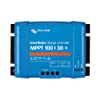 |
||
| 4 | Solar Epic MPPT 40A Solar Charge Controller |  |
||
| 5 | PowMr 60amp Auto MPPT Solar Charge Controller | 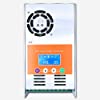 |
||
| 6 | Windy Nation P30L LCD 30A PWM Solar Panel Regulator Charge Controller |  |
||
| 7 | Acopower 40A MPPT Solar Charge Controller | 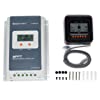 |
||
| 8 | Morning Star Sunsaver SS 20L 12V Solar Charge Controller |
The major purpose of this article is to assist you in reviewing the best Solar Charge Controller in the open market presently. We reviewed the best Solar Charge Controller based on best international practices and benchmarks available. Here are our review and our top picks for the best Solar Charge Controller on the market.
1. Morning Star Pro-StarPS-30 PWM Solar Charge Controller (Our Top Pick)
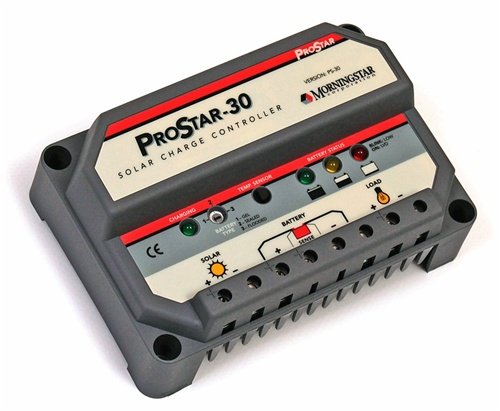
Morning Star Pro-Star PS-30 PWM Solar Charge Controller is a beauty to behold and one of the jewel products of Morning Star, a renowned manufacturer of Solar Charge Controller. This charge controller is highly recommended for people who are in need of a high-quality, reliable and durable Solar Charge Controller. The Morning Star Pro-Star PS-30 PWM Solar Charge Controller due to its unique fabrication and highly advanced technology help to significantly elongate the lifespan of the battery and also improve the performance of the solar system as a whole.
The Morning Star Pro-Star PS-30 PWM Solar Charge Controller is fabricated with state-of-the-art materials which makes it highly durable with a long lifespan, no wonder the manufacturers are confident in putting a whopping 5-year warranty on the controller. The Controller is armed with about 256 days of data logging, enhanced surge rating for heavy DC loads, and self-diagnostics among others.
The Morning Star Pro-Star PS-30 PWM Solar Charge Controller has a lifespan of 15-years and it is compatible with a system voltage of 12V or 24 V depending on your solar system need and it has a rated solar current of 30Amps. The Controller weighs 1.10lbs with a dimension of 7.30 x 4.50 x 2.80 inches which makes it relatively light when compared with its peers. The beautiful piece also has LED Indicator Lights.
- Durable.
- Self-Diagnostic.
- Affordable.
- None
2. Renology Wanderer – 30A Advanced PWM Negative-Ground Solar Charge Controller.
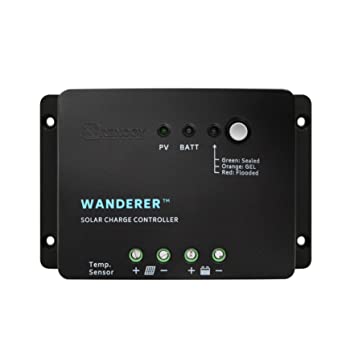
The Renology Wanderer- 30A Advanced PWM Negative-Ground Solar Charge Controller is equally among the top Solar Charge Controller presently available. A unique feature of this controller is the relatively cheap price in which it sold as a piece goes for about $25 which is considerably cheap when compared with other Controller of the same standards in the market.
The Renology Wanderer- 30A Advanced Negative-Ground Solar Charge Controller is fabricated with a temperature sensor which helps to detect the temperature of the battery and makes use of the data on temperature for accurate temperature compensation. The Renology Wanderer- 30A Advanced PWM Negative-Ground Solar Charge Controller is optimized for a 12V Solar system with a charging capacity of 30A.
The Renology Wanderer- 30A Advanced PWM Negative-Ground Solar Charge Controller comes with multi-faceted LED indicators which would make it easy for you to know the charge status and other revelation information about the battery. Thus with this controller, you can plan how to consume the energy stored in your batteries. The controller weighs 4.8 ounces and has a product dimension of 5.5 x 3.7 x 1 inches which comes in color black.
- Very affordable
- Temperature Compensation.
- Intelligent protection.
- No LCD Display
- Power OffNo remote monitoring
- Power OffNot waterproof
3. Victron Smart Solar MPPT100/30 Solar Charge Controller.
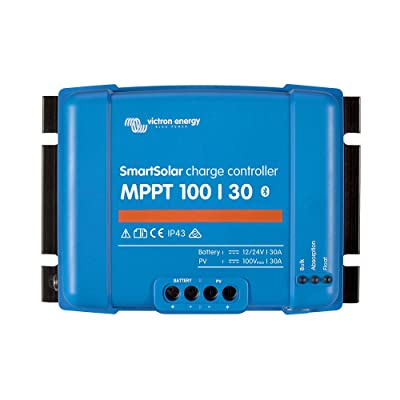
The Victron Smart Solar MPPT 100/30 Solar Charge Controller is a product of Victron which has a long and reputable standing of over 38 years in manufacturing of durable and reliable Solar Charge Controller. Their reputation doesn’t end only with the Solar Charge Controller as it extends to car and marine.
The Victron Smart Solar MPPT 100/30 Solar Charge Controller is uniquely designed to not consume space as it allows remote control through the aid of a Bluetooth chip which is embedded in it. The controller allows the use of Bluetooth when the VE. Direct port is used to connect to a Color Control GX. The Victron Smart Solar MPPT 100/30 Solar Charge Controller is good for controlling up to 440 watts of Solar Panels at 12V or 880 watts at 24V.
The Victron Smart Solar MPPT 100/30 Solar Charge Controller comes with a warranty of 5 years which testifies to the quality of the controller and the confidence of the manufacturer on the product. The Controller is designed to be Ultra- fast Maximum Power Point Tracking (MPPT) with a 98% peak efficiency. However, it is worthy of note that Victron Smart Solar MPPT 100/30 Solar Charge Controller is highly priced as a piece goes for about $227.
- Small.
- Durable.
- Bluetooth.
- Warranty.
- Expensive
4. Solar Epic MPPT 40A Solar Charge Controller
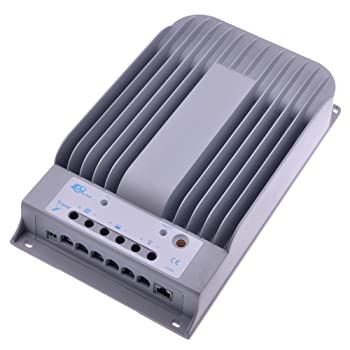
The Solar Epic MPPT 40A Solar Charge Controller is designed for off the grid Solar system which helps to administer the charging of batteries with its smart tracking algorithm which magnifies the energy from the Solar System.
It also prevents discharging of the batteries with its low voltage disconnect function (LVD). The Solar Epic MPPT 40A Solar Charge Controller has been purposely built to increase the lifespan of the batteries and also the general performance of the system.
The Solar Epic MPPT 40A Solar Charge Controller is armed with comprehensive self-diagnostics and other states of the art protections which helps to bring to the barest minimum, the damage of the system from installation mistakes. So with this controller, you can sure that your batteries are well protected.
The Solar Epic MPPT 40A Solar Charge Controller has a nominal system voltage of 12VDC/24VDC with a rated charge current of 40A. The rated discharge current of the controller is 20A and it has a maximum solar input voltage of 150VDC. The Solar Epic MPPT 40A Solar Charge Controller has a dimension of 302.5mm x 182.7mm x 63.5mm and weighs 2.9kg.
- Low Voltage Disconnect.
- Durable.
- Self-Diagnostics
- Long Life Span.
- Expensive
5. PowMr 60amp Auto MPPTSolar Charge Controller.
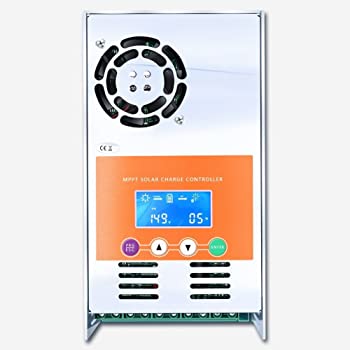
The PowMr 60amp Auto MPPT Solar Charge Controller which is manufactured by PowMr. The Controller is uniquely fabricated with built-in DSP controller with a highly functioning automatic battery voltage detector. It also has intelligent fan on a temperature of fewer than 45 degrees.
A surprising negative feature of the PowMr 60amp Auto MPPT Solar Charge Controller is the fact that it comes with a very short warranty of 2 years, this speaks volumes on the confidence of the manufacturer. The Controller features a 3-stage battery charging algorithm that allows quick, efficient and safe battery charging. It has a dimension of 10 x 8 x 3 inches and has a weight of 2.87 pounds.
The PowMr 60amp Auto MPPT Solar Charge Controller has dual fans which aid the cooling of the system and helps it to achieve higher heat dissipation. It features a green backlight LCD display which helps to indicate the status and also a LED indicator which clearly shows the charging level and faults of the Charge Controller.
- Cooling system.
- Durable.
- Expensive.
- Power OffWarranty
6. Windy Nation P30L LCD 30APWM Solar Panel Regulator Charge Controller
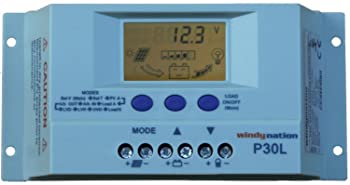
The Windy Nation P30l LCD 30A PWM Solar Charge Controller is a uniquely built controller which is high-ended. It is a PWM Solar Controller with a digital display which informs you of all the necessary battery information such as the amperage, voltage, load control, etc. The Windy Nation P30l LCD 30A PWM Solar Charge Controller is designed to be for 12V and 24V batteries and it features advanced electronic protection.
The dimension of the Windy Nation P30l LCD 30A PWM Solar Charge Controller is 7.4 x 1.9 x 3.5 inches and it weighs 13.6 ounces. The controller makes the cut to be among our best Solar Charge Controller due to its relatively cheap price. The Windy Nation P30l LCD 30A PWM Solar Charge Controller is priced at $44 which clearly makes it affordable for most people.
- Battery Temperature Sensor
- Affordable.
- Not waterproof
7. Acopower 40A MPPT Solar Charge Controller
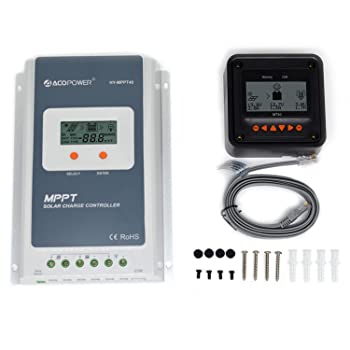
The Acopower 40A MPPT Solar Charge Controller is also another excellent Solar Charge Controller for your Solar System. Although the price of the Controller is a bit expensive, it clearly offers a full value for all penny spent on it. The Acopower 40A MPPT Solar Charge Controller provides you with everything required to optimize your batteries, charging your batteries to prevent over-charging and also regulating discharging.
The Acopower 40A MPPT Solar Charge Controller allows you to easily monitor the progress of your batteries, which is done via the LCD display system information. Also, the Controller allows you to program the type of battery that is in use. In addition, the Acopower 40A MPPT Solar Charge Controller which has a warranty of 18 months is built to automatically detect the voltage of the batteries in use.
- Automatic Voltage Detection.
- LCD Display.
- Expensive.
8. Morning Star Sunsaver SS 20L 12V Solar Charge Controller
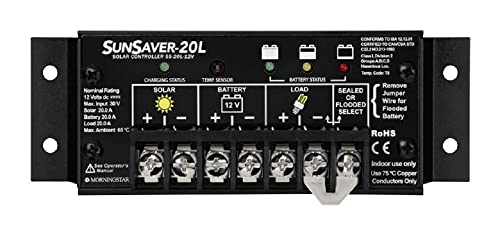
The Morning Star SS 20L 12V Solar Charge Controller is a third-generation Sunsaver charge controller which has multi-color charging status LED. The controller has a 4-stage series PWM charging. The Morning Star SS 20L 12V Solar Charge Controller is designed to survive and withstand harsh weather conditions with its epoxy encapsulation, marine-rated terminals, anodized aluminum case, etc.
So with this controller, you have issues placing it where you want it to be. It must be pointed out at this point that the Morning Star SS 20L 12V Solar Charge Controller is a highly reliable controller.
The Morning Star SS 20L 12V Solar Charge Controller has a maximum solar current of 20Amps and a maximum Load current of 20Amps with a system voltage of 12V. It is light weighed with it 0.23kg and a dimension of 6.0 x 2.2 x 1.3 inches. The Morning Star SS 20L 12V Solar Charge Controller is fabricated with quality materials and as such, the manufacturer has no fear in giving out a warranty of 5 years on the controller.
- 4-stage series PWM charging
- Reliable
- Rugged
- Expensive
How To Set Up a Solar Charge Controller?
Before delving into the steps in setting up the Solar Charge Controller, we would first look at the supplies needed and the tools required for setting up the Solar Charge Controller. The Supplies and tools you will require are:
Supplies
- 1 battery charger
- 1 power inverter
- 1 Rubbermaid tote or other containers
- 2 AWG cable
- At least one 12 Volt marine deep cycle battery
- Battery charger
- Charge controller
- Mechanical Lugs
- Solar panels
Tools required
- Cable cutters
- Crescent Wrench
- Drill
- Red electrical tape
- Screwdriver
Steps for setting up the Solar Charge Controller
Step 1: Charge the Batteries
Before doing anything, you want to be sure that your batteries are fully charged to capacity. If your battery is not fully charged, you should charge them first.
Whilst your batteries are being charged, instead of just waiting, you could use the opportunity to set up your solar panels by placing them at the appropriate location you want them placed and connecting them together.
Step 2: Arrange the Batteries
After your batteries are completely charged, the next step is to put the batteries into a box or container. When it is being placed in the box or container, you must ensure that all the positive (+) terminals of the batteries are made to be on the same direction and all the negative (-) terminals of the batteries are also made to face the other direction. When they are properly arranged, you will measure the distance of the terminals to each other so as to be able to create jumpers.
Step 3: Make Jumper Cables
The next step is to create jumpers out of 2 AWG cables. This would be used to connect the terminals of your batteries together.
Step 4: Connect the Batteries in Parallel
After making the jumpers, the next step is to connect the batteries in parallel.
Step 5: Add Holes in the Lid
The next step is to add holes in the lid for you to be able to run the wires for the charge controller and the inverter. This is dependent on where you want to place the Solar charge controller if you intend to place it outside, then it should be visible. If you want it concealed, you could just easily put it inside the container for a more cloaked look.
Step 6: Connect the Inverter
The next line of action is to connect the Solar charge controller and the inverter to the batteries. Please ensure that the inverter is turned off before attempting to connect it. Also, for safety reasons and to avoid damaging the solar system, it is advisable that the charge controller is not connected to the solar panels yet.
Step 7: Connect the Solar Charge Controller
At this stage, all parts of your solar system should have been wired together. What is now to be done is to connect the solar charge controller to the solar panels and turn the inverter on and check to see that it works.
Step 8: Start enjoying your solar charge controller
You can now start enjoying your Solar Charge controller.
How Does a Solar Charge Controller Work?
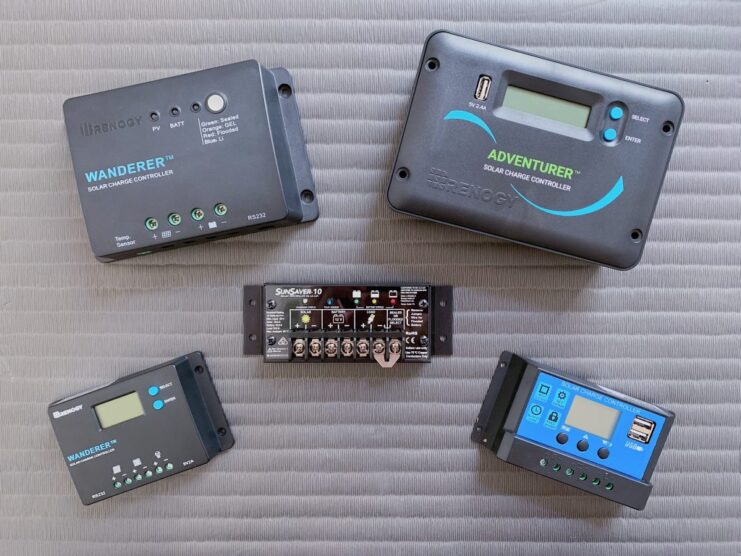
A solar panel charge controller is a voltage or current controller that helps in charging the battery and holds the electric cells from high charging and extends the battery life.
The solar charger controller regulates the voltage and current that comes from the solar panels or the PV array going to the battery. Most “12 volts” solar system panels produce about 16 to 20 output voltage. If the power produced is not regulated, the batteries will be overcharged and get damaged. Most solar batteries need 14 to 14.5 volts to get fully charged.
Solar charge controllers function in a three-stage charge cycle:
-
- Bulk – The charge controller is directly connected to all solar panels to the batteries in the bulk charging stage. The overall voltage of the solar PV panel trickles down to match the voltage of the battery. The total solar panels’ current output is unloaded into batteries. The bulk stage provides the maximum charge to the solar battery. This is also known as the constant current stage. The voltage increases while the battery gets charged.
- Absorption – At this stage, the charge controller slowly tops up the remaining charge. This process takes place due to the maintenance of a constant voltage of 14.4V. There is a limitation on the flow of current to the lead-acid batteries. The overall chemical reactions take place inside the battery of the pulse width modulation solar charge controller. This chemical reaction stops the battery from overheating and maintains the charging progress at the safest possible rate.
- Float – Once the battery is fully charged, the charge controller immediately switches to the float stage. There will be a trickle of current at 13.8V in the trickle-charge mode.
Things to Look for When Buying a Best Solar Charge Controller
A solar charge controller is very important and delicate to your solar system because, without the right solar charge controller, your whole solar system would not work efficiently as you would be constantly faced with overcharging and discharging. To know the best solar charge controller, you must consider the following important features.
Type of Solar Charge Controller
If you want to take advantage of solar energy and considering powering your household with an off-grid power system to save money, then you can opt for installing solar power systems on your roof. But before having solar power systems, you may need to know some processes to maximize solar power and to ensure safety. One of the essential things to remember is a solar charge controller.
Basically, there are two major types of Solar Charge controllers in the open market for now. They are the MPPT (Maximum Power Point Tracking) controller and the PWM (Pulse Width Modulations).
The MPPT is designed to provide larger effects than the PWM. They are advanced and have varying functions which certainly help you to protect and extend the lifespan of your Solar system batteries. However, the PWM is kind of elementary and is available for very cheap prices.
Manufacturer’s Pedigree
Another thing to consider before placing your money on any Solar Charge Controller is the pedigree/history of the manufacturer. As you are aware, there are many Solar Charge controllers in the market today, so an easy way of sieving the poorly made solar charge controllers away is by checking the history and also the pedigree of the manufacturer.
Durability
The Solar Charge Controller is designed to function almost 24 hours a day and 7 days a week so you don’t want to fall into the trap of buying Solar Charge Controllers that are not durable. Buying Solar Charge controllers that are not durable could indeed be frustrating and exhausting. In determining the durability of the Solar Charge controller, you have to check the components with which the Solar Charge Controller is made. This will certainly show how durable the controller is.
Voltage consideration
Before deciding the best Solar Charge Controller for your Solar Panel, it is pertinent to know the type of voltage of your Solar Panel. There are varying types of voltage of 12V or 24V and they tend to have a voltage of resume power supply of 11.8V or 23.6V and a charging current of 10A.
Although most users readily buy the 12V unit, it doesn’t necessarily mean it is the best. The best Solar Charge Controller for your Solar panel is the one that has the voltage as instructed by the manufacturers of your solar panel. When you buy a Solar Charge Controller that has below or above the voltage requirement, it would certainly not provide the desired result.
Waterproof
This is a necessary feature to consider before buying Solar Charge Controller. This is because Solar Charge Controller, although could be placed indoors, is also placed outdoors. You don’t want to buy a Solar Charge Controller that would get damaged due to water. To know whether the Controller is waterproof or not, you should check the specification and confirm with the seller.
Warranty
It is common knowledge that the Solar Charge Controller is expected to last as long as your Solar System. Just like every other mechanical device, they are susceptible to factory damage.
So, you want to be sure that the Solar Charge Controller would be replaced when any fault is detected. Aside from the fact that the product would be replaced if any fault is detected, the warranty also gives assurances that the product is well fabricated and the manufacturer is willing to vouch for it.
Most defective and not well fabricated Solar Charge Controller don’t have a warranty. The Manufacturers are aware of the quality of the controller and thus, avoid giving a warranty for the controller.
What is an MPPT Charge Controller?
The maximum power point tracking or MPPT solar charge controller technology helps enhance the performance of the battery charging state. An MPPT controller is a higher efficiency DC-DC converter technology as compared to shunt controller and pulse width modulation technologies. A non-MPPT solar controller is the same as connecting a battery directly to the solar power module. To put it simply, the MPPT charge controller technology is used on solar PV systems and wind turbines to increase power extraction under all kinds of conditions.
Final Review of the Best Solar Charge Controller
The importance of the Solar Charge Controller cannot be overemphasized. It is a fulcrum on which your whole solar system rests. If you use the best solar charge controller, you can be confident that your batteries are at their optimum, charging well and not discharging unnecessarily.
If you are unsure of the best Solar Charge Controller to buy for your Solar system, then you can go with our highly recommended Morning Star Pro-Star PS-30 PWM Solar Charge Controller as it does not only offer a very good value for all money spent on it, it also strong, reliable and durable.
All user we interacted with that has used the Morning Star Pro-Star PS-30 PWM Solar Charge Controller only had positive things to say about the controller.
